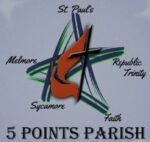1824 – 1873
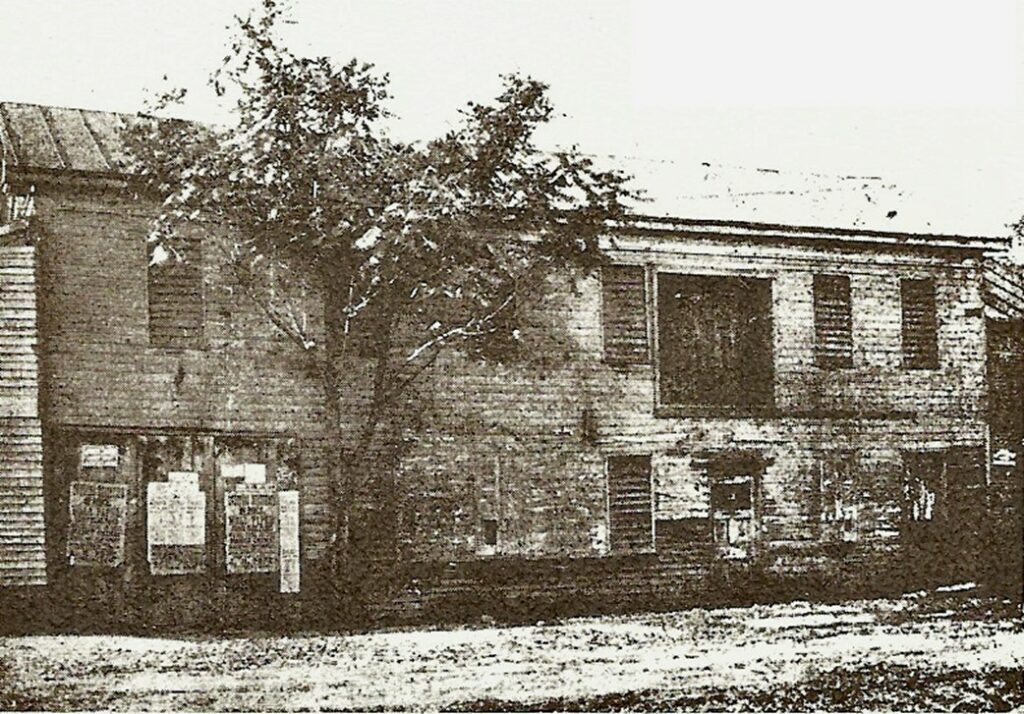
First Frame Building in Tiffin Used For Early Meetings of the Methodist Church.
Area historians agree that Methodists in Tiffin held services as early as 1823 in the Hedges building on what is now Court Street. James Montgomery, a minister in the Methodist Episcopal Church led these early services. The Hedges building served several purposes. The basement was a jail, the first floor was a store, and the second floor was used as a court room during the week and for church services on Sunday. Elijah Fields was the first regular preacher, organizing a class in 1824. This date is considered the founding date for St. Paul’s congregation.
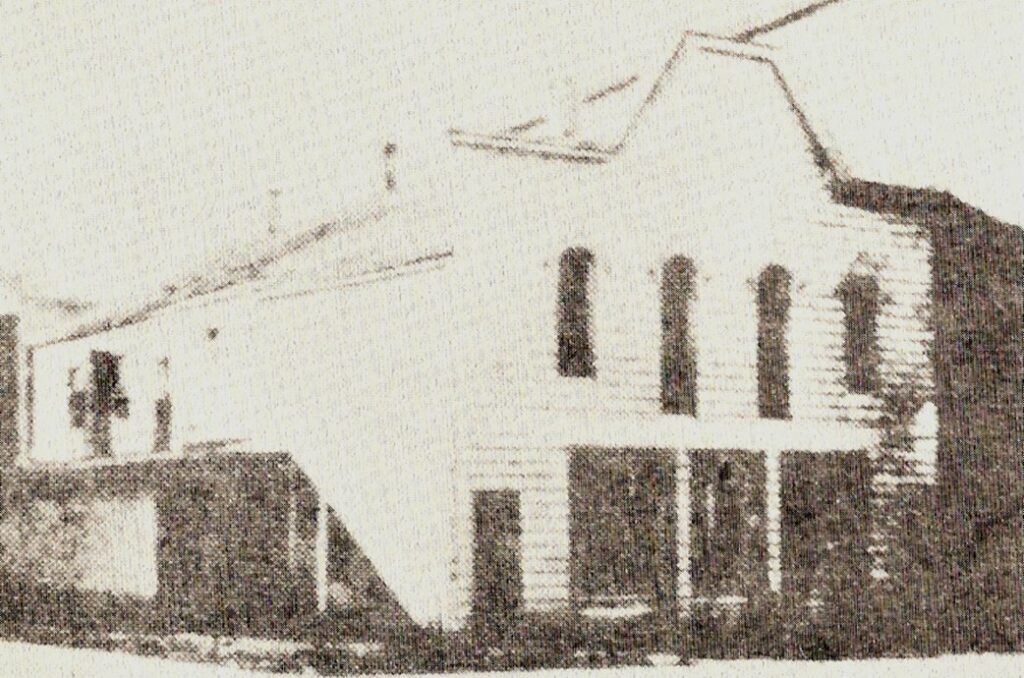
First Methodist Church Building on East Market Street, Original was Brick
The first building erected especially as a Methodist church was a small brick structure, early English in style. It stood on the south side of Market Street, halfway between the Market Street covered bridge and Monroe Street. This building was dedicated in 1828. The church had two entrance doors, the men entering one and the women the other; they were seated in that same manner inside. The illumination inside the church was provided by dipped tallow candles. There were two on each side, one on each side of the two center posts, and two on the pulpit.
The congregation was growing and soon outgrew the first building. Land was purchased for a new structure in 1841. In August 1848 the congregation was admitted to the North Ohio Conference of the Methodist Episcopal Church. On July 29, 1849, the second building was dedicated. It was located on the corner of Market and Monroe Streets (where Croghan Colonial Bank is now). It was said to be an impressive two-story brick structure, with the auditorium for worship services on the second floor and the Sunday School room and three lecture rooms below. At the north end was a choir loft, where in later years the first big pipe organ in Tiffin was installed. At the rear of the building was a one-story, one room brick building used as a pastor’s study and for trustees’ meetings. Several feet further south stood the parsonage, also a two-story brick structure. In the winter of 1850 great revival services, continuing over seven weeks, added about 100 new converts to the church membership.
Once again the congregation was on the move and property was purchased on Madison Street in April 1871. Groundbreaking for the third, and current building, occurred in June 1873.
1874 – 1923
Throughout 1874, work continued on the new building for St. Paul’s Methodist Episcopal Church. The foundation was completed in May and the cornerstone was laid in June. Brick work also began that month. In October 1874, as work was completed on the roof, a tragedy occurred. Charles E. Jack, a carpenter working on the northwest corner of the building, was killed when he slipped and fell almost seventy feet to the ground. Nearly two weeks later another worker, Marshall Thompson fell approximately 60 feet from a temporary platform in the bell tower. Although he sustained a broken leg in the fall, he fortunately survived the accident.
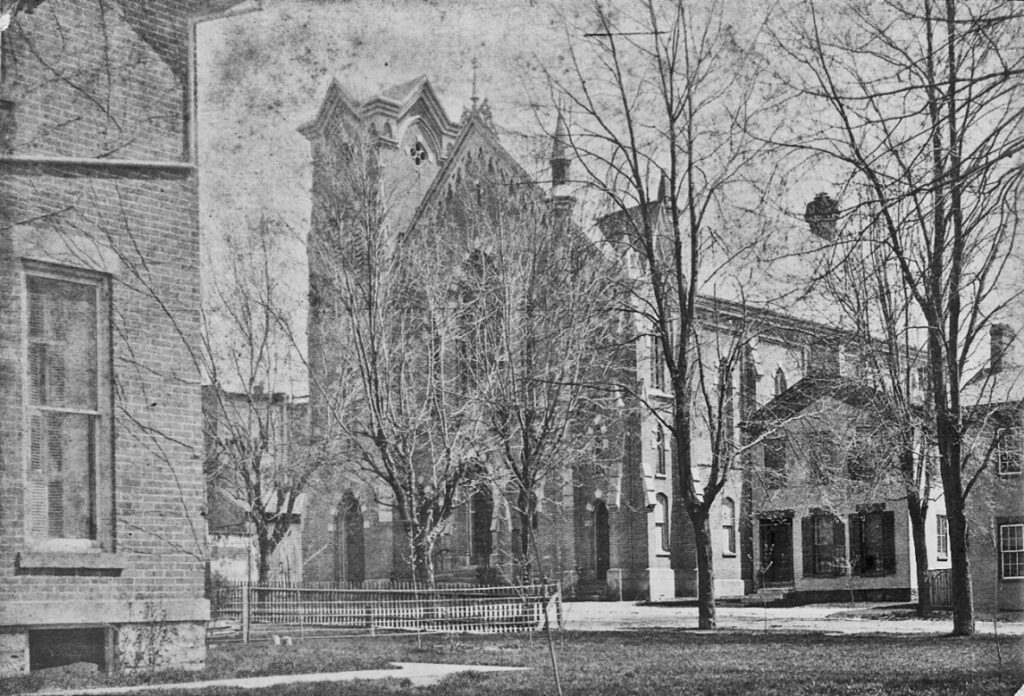
St. Paul’s Methodist Episcopal Church – with 3 Front Entrances
On February 21, 1875 the dedication of the “basement rooms” of the new church took place. There were four rooms on the first floor. Church services were held in the main room (now the Fellowship Hall). In the rear of the main room and connected to it by folding doors were three rooms. Two were called the church parlors and were used for prayer services and Bible classrooms. The third, on the west side was for the infant class. Although the entire outer structure of the building was completed in 1874, the nation was experiencing an economic depression and the upstairs “audience room” or sanctuary was not completed for nine years.
In the spring of 1883 work began to complete the interior of the second floor. In October of that year, plans were also underway to erect the Edison Electric Illuminating Company building on Monroe Street. In December 1883, quick-thinking contractors wired the church for electric lights, making St. Paul’s Church the first public building in the world to be wired for electricity while being built. To mark the occasion, Thomas A. Edison presented the church a splendid electric light chandelier – still in use today.
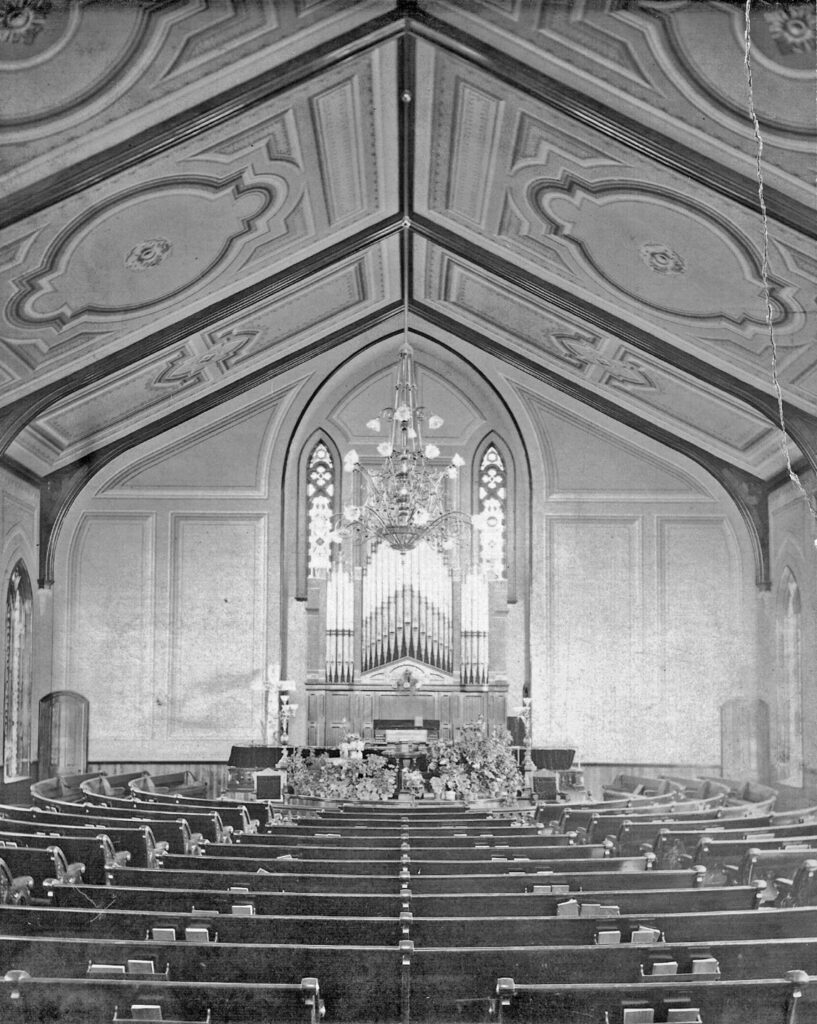
St. Paul’s Methodist Episcopal Church – Completed Interior
On January 6, 1884 the newly completed building was dedicated. Although the temperature was below zero, the morning services were attended by an audience which completely filled the church. Crowds filled the church again that night for evening services. Many were doubtless drawn to the church to see the Edison electric light which beautifully illuminated the room and presented a scene never before witnessed. The total cost of the first two phases of construction on this building was about $50,000. The membership of the church was 360 at that time.
Civil War General and nationally known orator, William Harvey Gibson was a member of St. Paul’s church. When he passed away on November 22, 1894, his funeral services were held at St. Paul’s. Special trains from Cleveland, Columbus, Toledo and way stations brought men of note from all parts of Ohio. An estimated 9,000 people processed through the church to pay their respects.
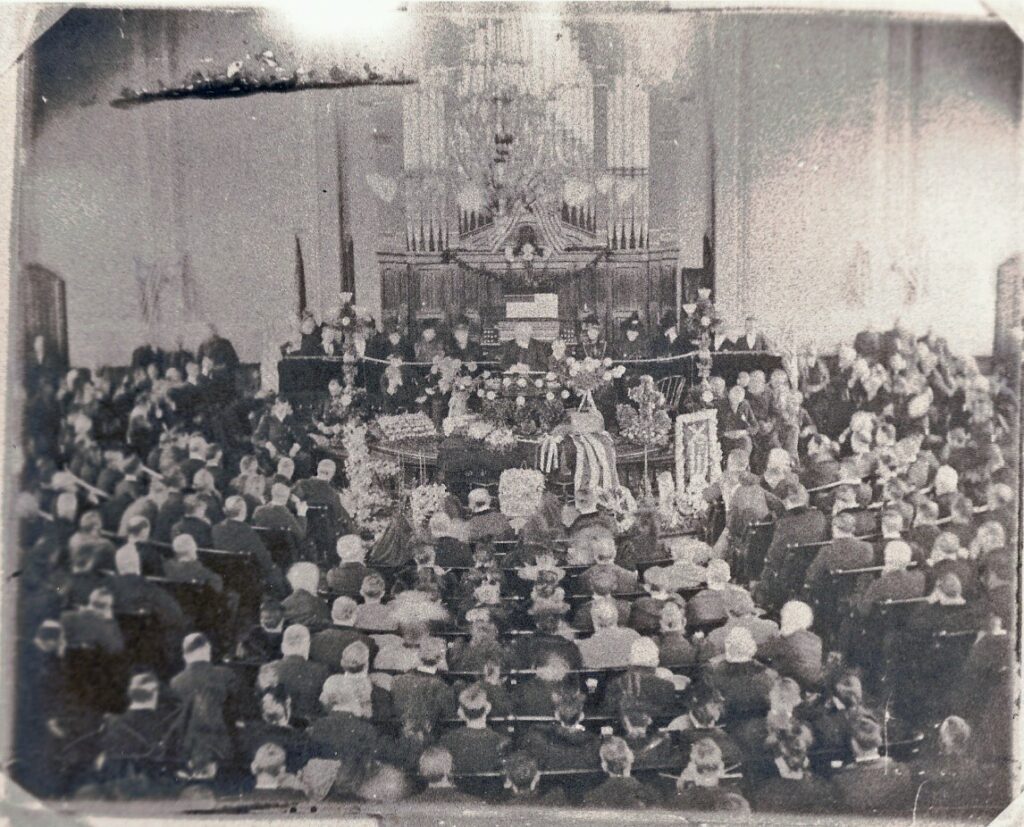
The Funeral of General William Harvey Gibson in 1894
By 1896, St. Paul’s Church had a regular schedule of Sunday School at 8:45 a.m. and worship services at 10:00 a.m. and 7:30 p.m. on Sundays. There were 18 Sunday School classes with a membership of 400. Church membership was 600.
1924 – 1973
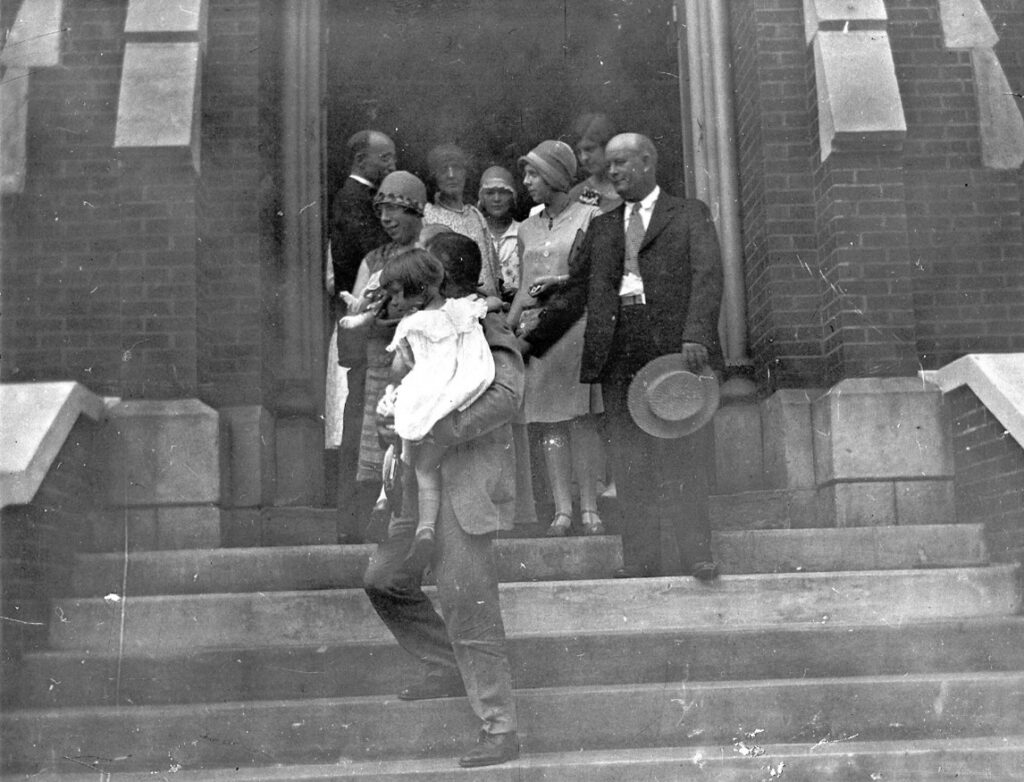
Rev. Norman H. Flickinger greets members. The man with the hat is J.L. Patterson, contractor for the Education Wing.
In 1927, when times were good, it was decided to build a Religious Education wing and add new brick veneer to the existing building at an estimated cost of $72,000. The groundbreaking took place on Palm Sunday in 1928. The dedication service of the completed building took place on Sunday, March 10, 1929. This was followed by a full week of activities and events. The new addition contained 43 rooms in all, including 22 class rooms, 5 assembly rooms, a ladies’ parlor, with kitchenette, choir room, nursery, boy scout room, library, shower rooms, toilets on three floors, and a fully equipped kitchen and gymnasium. This was just seven months prior to the Great Depression that started in October of 1929.
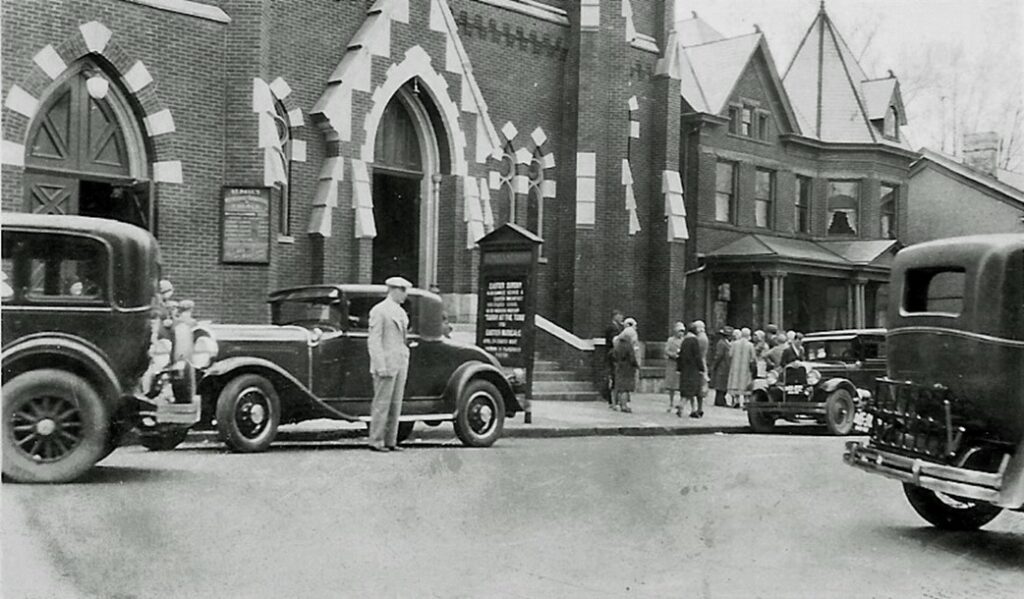
Outside St. Paul’s Church, Easter 1930
In the 1930’s financial affairs were of much concern. Pipes were damaged by freezing, windows in the new building needed attention and in 1937 the building debt was still $50,000. In 1939 salaries were cut twenty percent and other emergency steps were taken. The church debt was $40,000. The mortgage on this building was not burned until October of 1943. A bequest from Jessie Hershiser, for 50 years a librarian at Tiffin’s Library, who served for fifty years as superintendent of the primary department of St. Paul’s Sunday School, made this possible.
The 120th anniversary of St. Paul’s was celebrated in 1944. Bishop Edwin Holt Hughes, also a former St. Paul’s pastor, was the speaker. The kitchen was moved from the basement to the rear of the assembly room in 1948. In the late 1940’s as many veterans and their families came to St. Paul’s the Fellowship Class was formed. In 1951, new electrical wiring and switches were installed in the sanctuary. The Partners-In-Faith Class was organized in 1957. A new pipe organ was also installed that year, at a cost of $12,000. That same year a new roof was put on the education wing and St. Paul’s sponsored a drive-in worship service at a theatre north of Tiffin. In 1961, the gymnasium and nursery were remodeled at a cost of $33,228.
By 1966, church membership was 780 with 400 church families. The average church attendance was 217. Following the national church merger, the local church’s name becomes St. Paul’s United Methodist Church in 1968. In 1970, the church library was organized. Property was purchased on Monroe Street in 1970, for use as a parking lot. After three years of fund-raising an elevator was installed in 1973.
1974 – PRESENT
1974 was the centennial year for the church building and the sesquicentennial anniversary of the congregation. The celebration began with a pot-luck supper, old fashioned dishes, dress, and antique displays. The Edison chandelier was cleaned, polished and rededicated. The church membership was 611 with an average weekly attendance of 211. There were 147 members of the church school.
In 1980, a mid-week Christian Education program for children in preschool through junior high, simply called Youth Club, was started. This program allowed the church to reach children both from the congregation and the greater community. The program met on Wednesday evenings and provided dinner, crafts, games, mission opportunities, music and a Bible class. Youth Club proved very successful and still meets weekly on Wednesday nights from October through February.
In 1985, St. Paul’s was designated as a Historic Site of the United Methodist Church. This designation was made based on several considerations: The St. Paul’s Congregation was the first protestant religious body formally organized in Tiffin, two pastors who served the church were later elected to the office of Bishop, four sessions of the North Ohio Annual Conference and one session of the Michigan Annual Conference were hosted by St. Paul’s and the fact that St. Paul’s was the first building in the world to be wired for electricity at the time of its construction. A day of celebration was held on February 17, 1985 and a plaque was added to the front of the church building.
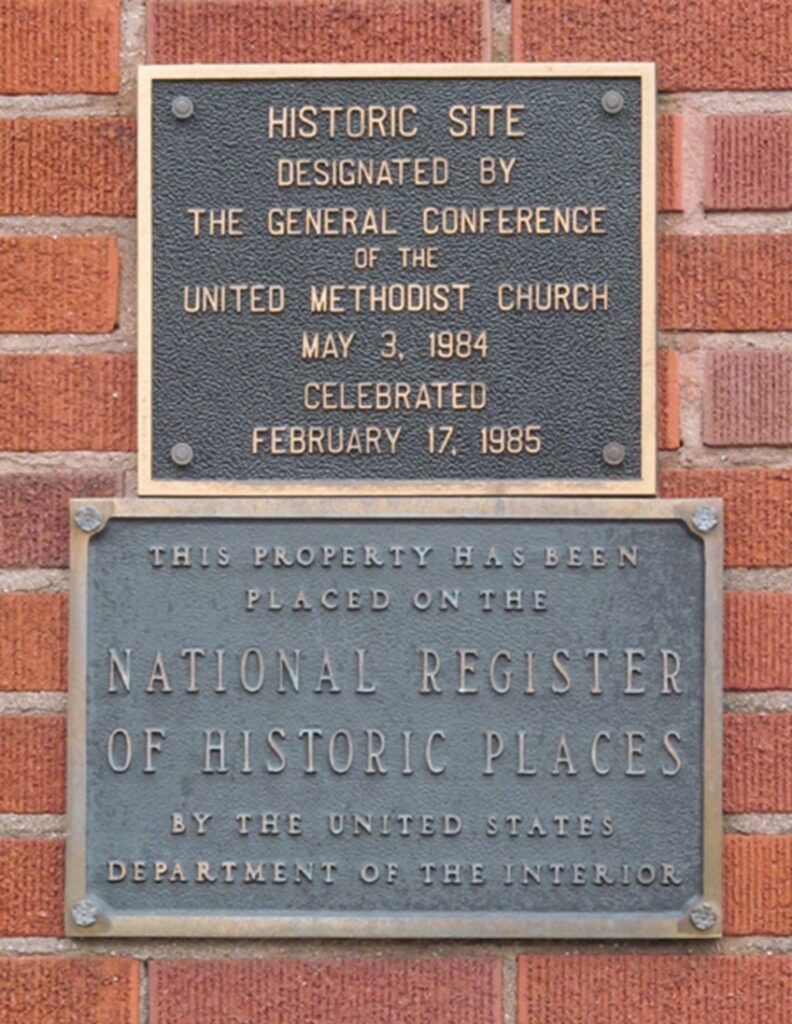
In 1986, the Ecumenical Sharing Kitchen was formed. It sought to provide meals to the hungry in Tiffin and Seneca County. Donations of food and other items were received from many sources. Many area churches and organizations help serve in the kitchen, as well. This program continues to serve meals every week on Mondays and Thursdays and the third Saturday of each month.
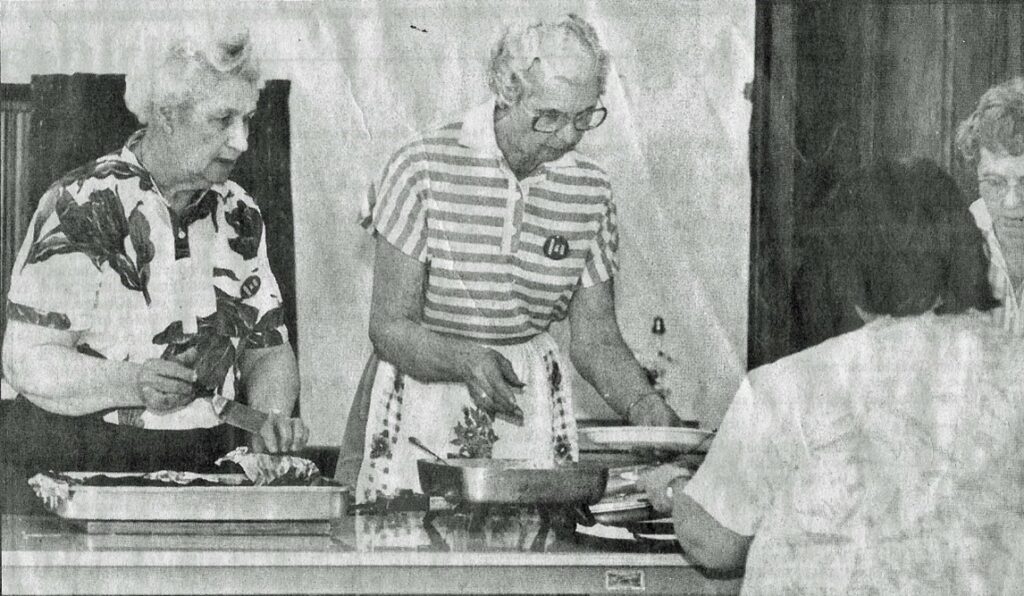
Volunteers Serve Meals at the Sharing Kitchen in 1986
A new parsonage was purchased on Lelar Street in 1986. The former parsonage, located next to the church, becomes the home of Patchworks house, an organization that provides services to families in crisis.
In 1999, a new sound and video system was installed in the sanctuary. This allowed for greater flexibility with microphones, as well as the capability of projecting video during services. Audio and video recording of services also became possible. This system was dedicated on November 21, 1999 in memory of Helen Bean.
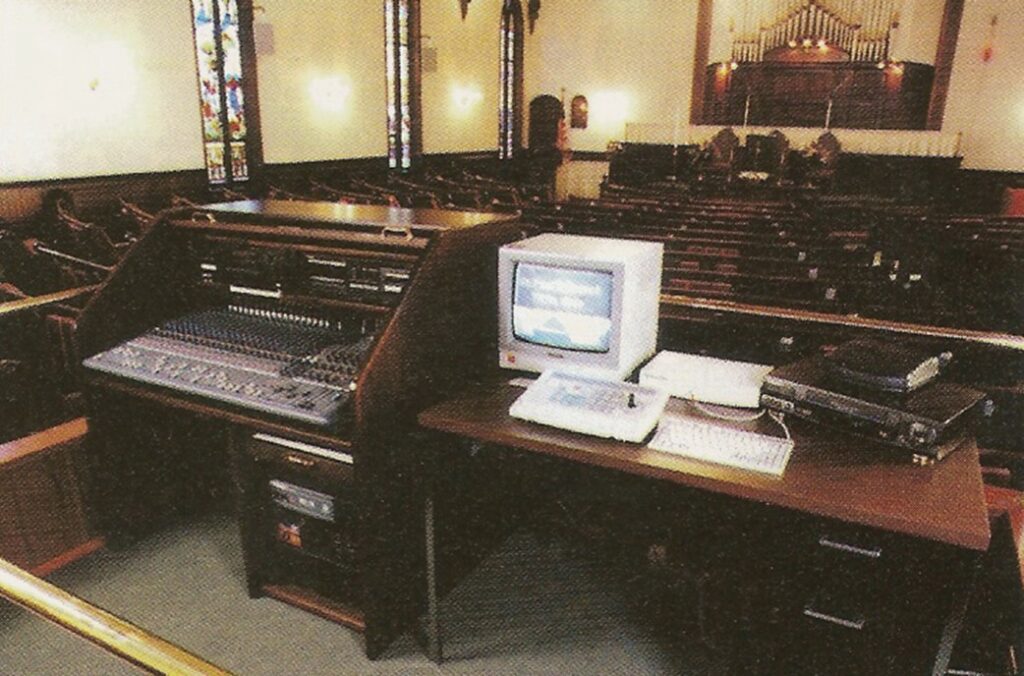
The sound board and video equipment Installed in 1999, in memory of Helen Bean
A contemporary worship service, called The Light began in September 2000. It included a worship experience with more multi-media elements and the music was provided by a newly-formed praise band. The contemporary services continued until March 2009, when a more blended form of service was adopted.
In 2001, the church received an Ohio Historical Marker for its early electric illumination. This was dedicated on November 4, 2001.

In 2010, property at the corner of Monroe and Madison Streets (next to Patchworks House) was purchased. It has been used as green space for outside worship services and recreation during Vacation Bible School. An illuminated sign was placed on this corner in 2012, giving the church greater visibility.

PASTORS WHO HAVE SERVED
ST. PAUL’S UNITED METHODIST CHURCH:
1824 Elijah H. Fields
1825 John W. Clark
1827 Ezra Brown
1828 Alvin Billings
1828 Ezekiel Cooper
1829 William Sprague
1829 Ezekiel Gavitt
1830 Ezra Brown
1830 E.R. Jewett
1837 Thomas Thompson
1839 Jonathon Edwards Chaplin
1840 Thomas Thompson
1841 William Runnels
1841 John L. Ferris
1842 George W. Breckenridge
1843 M.L. Starr
1843 Elijah Shaeffer
1844 Elijah Henry Pilcher
1845 E. McClure
1846 John T. Kellam
1847 Hiram Humphrey
1848 E.S. Grumley
1849 Samuel L. Yourtree
1851 Alexander Nelson
1852 Leonard B. Gurley
1854 John Quigley
1855 Alexander Nelson
1855 N. Redd
1855 John Carney
1856 Chester L. Foote
1857 Edward R. Jewett
1858 John A. Mudge
1860 Eurotus Hastings Bush
1861 George S. Philips
1863 T.F. Hildreth
1864 Aaron J. Lyon
1867 Lorenzo Warner
1868 W.H. Seeley
1871 George W. Collier
1873 G.A. Hughes
1876 John Whisler
1878 J.W. Mendenhall
1881 Gaylord H. Hartupee
1882 James S. Reager
1885 William Fraser McDowell*
1890 Edwin Holt Hughes*
1890 Newell S. Albright
1895 W.C. Dawson
1897 Charles Gallimore
1900 Elvero Persons
1902 Robert L. Waggoner
1908 Worthington B. Slutz
1910 Oliver J. Coby
1912 Charles Whitfeld Kennedy
1916 Frederick W. Hass
1916 Edgar Haga Warner
1922 Amos Asahel Brown
1925 Homer W. Courtney
1929 Norman H. Flickinger
1931 Paul E. Hollingshead
1936 John Howard Palmer
1941 John G. Koontz
1948 Fred W. Knickrehm
1952 Vernon C. Tyree
1954 Robert H. Courtney
1957 Glenn F. Lockard
1961 Leland Stanford Wiley
1971 Paul Clark
1972 Ward Hines, Associate
1974 Harold T. Milford
1977 Frank Tully
1982 I. Melville Wohrley
1988 Gordon W. Ruggles
1997 Gail Angel
2002 Scott Blevins
2006 Gary Hicks
2009 Barbara SilverSmith
2010 Nathan Howe
2012 Hannah Tucker
2018 Charlene Thomas
